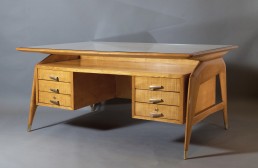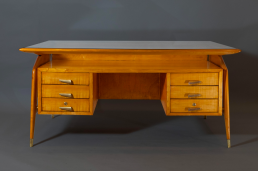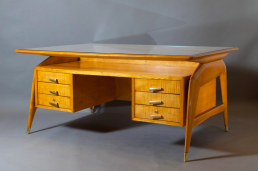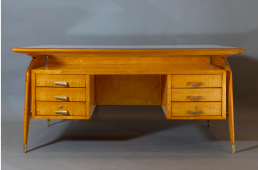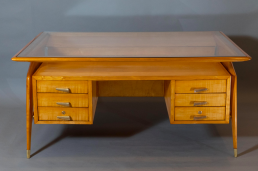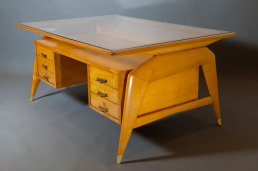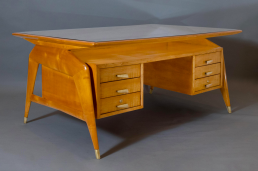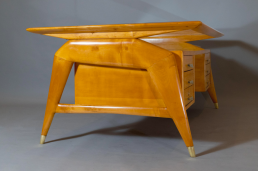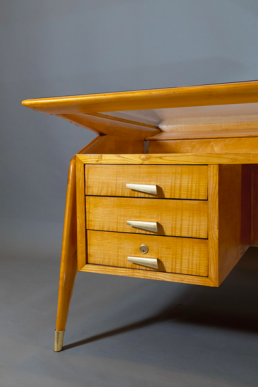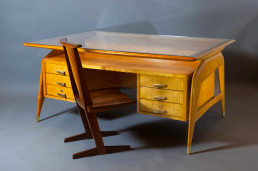Product Description
A floating top with a rectangular glass insert, in a trapezoidal frame with rounded edges, hovers over an architectonic body in polished fruitwood, every angle, surface, and void carefully calibrated. The prismatic legs are beautifully modeled, an arresting interplay of asymmetrical volumes that swell to unusual taper
anthropo into growing and tapering
expanding and
The desk’s biomorphic, almost anthropomorphic shapes the culmination of the organic inspiration that permeates de Carli’s work.
anthropomorphism the apogee nod to the organic inspiration that permeates De Carli’s work.
A perfect marriage of form and function, this sculptural At the intersection of art and use, this Architectonic
dimensional
distinct
architectonic
anthropomorphic a nod to the organic inspiration that permeates De Carli’s design ethos.
tour de force of imagination
The dean of Milan’s Faculty of Architecture in the 1960’s and a respected and prolific writer throughout his career, de Carli used his exuberant yet practical designs as proving grounds for a philosophy centered on human form and movement. He held that “a chair, an armchair or a table must be elements in which one can feel an individual presence,” and set out to design furniture that responded not to built structures, but to human lives — or, as he wrote, “the thinking and the actions of the people who live in that environment.”
De Carli was an advocate of space that ‘flowed’, and many of his designs incorporate details that suggest movement — from the curved edge of a desk to the sloping line of a chair.
It is a constant research that urges him to create new forms, contributing to the renewal of taste and trends in Italian architecture and design.
places the person at the center of the project
Through the publication il mobile italiano (1957-60) he promoted renewal of traditional furniture production centres and the coming together of international design culture, young architects and local artisans.
His years with Ponti shaped young Carlo De Carli’s language and approach to design. He had a fine sense for modern materials, functional design and industry with a willingness to experiment and invent.
A modern Renaissance man, Italian designer
Carlo de Carli wove his personal philosophy into his furniture creations. He believed that furniture should suit human movement and the surrounding environment, and each piece was made not only with an eye to form but also for everyday practicality.
they are made to be lived in. As a result, his comfortable, functional and inviting designs
He worked with the legendary architect and designer Giò Ponti before setting up a studio of his own, embarking upon a long career that would help shape 20th-century Italian design.
his philosophy centred on the rhythms and continuities in the relationships between space, material and the human body.
He argued that ‘a chair, an armchair or a table must be elements in which one can feel an individual presence’, and set out to design furniture that responded not to built structures, but to human lives — or, as he wrote, ‘the thinking and the actions of the people who live in that environment’.
De Carli was an advocate of space that ‘flowed’, and many of his designs incorporated details that suggested movement — from the curved edge of a table to the sloping line of a chair.
For de Carli, this sense of movement — or speed — was the ‘new rhythm of architecture’, and ‘the wonderful poetics of life in movement’ was something he continued to believe in passionately.
swooping, architectonic lines
As the Dean of Milan’s Faculty of Architecture in the 1960s and a onetime colleague and disciple of Gio Ponti’s, de Carli’s innovative designs are widely recognized for their vitality/ dynamism, and excellent craftsmanship. A respected academic and writer, his philosophy focused on the integration of space, material and the human body and gesture,
Dean of the Faculty of Architecture from 1965 to 1968 and teaching there until 1986. A respected academic and writer, his philosophy focused on the integration of space, material and the human body and gesture, and with this ideology he effectively engaged a dialog between design, universities and the craftsmanship world.
“He believed that furniture should suit human movement and the surrounding environment
Italy, 1950s.
Carlo de Carli (1910 – 1999)
An important sculptural desk with six drawers by seminal midcentury architect and theorist Carlo de Carli, in fruitwood with polished brass handles and sabots. The floating top, fit with a rectangular glass insert that reveals the fruitwood plateau below, has rounded edges and sits in a trapezoidal frame. It hovers over an architectonic body whose every angle, surface, and void is carefully calibrated. The prismatic legs are beautifully modeled, an arresting interplay of rounded, asymmetrical volumes that swell and taper, culminating in jauntily angled feet. The desk’s anthropomorphic curves are emblematic of the organic inspiration that permeate’s de Carli’s work. Its dimensionality and playful asymmetry — characteristics of his most innovative designs — speak to de Carli’s
The desk’s dimensionality, playful asymmetry, and anthropomorphic curves— characteristic of his most innovative designs — are emblematic of the organic inspiration that permeates his work. They speak, most importantly, to de Carli’s insistence on centering the body.
The dean of Milan’s Faculty of Architecture in the 1960’s and a respected and prolific writer throughout his career, de Carli used his exuberant yet practical designs as proving grounds for a philosophy centered on human form and movement. He held that “a chair, an armchair or a table must be elements in which one can feel an individual presence,” and set out to design furniture that responded not to built structures, but to human lives — or, as he wrote, “the thinking and the actions of the people who live in that environment.”
De Carli was an advocate of space that ‘flowed’, and many of his designs incorporate details that suggest movement — from the curved edge of a desk to the sloping line of a chair.
It is a constant research that urges him to create new forms, contributing to the renewal of taste and trends in Italian architecture and design.
anthropo into growing and tapering
expanding and
The desk’s biomorphic, almost anthropomorphic shapes the culmination of the organic inspiration that permeates de Carli’s work.
anthropomorphism the apogee nod to the organic inspiration that permeates De Carli’s work.
A perfect marriage of form and function, this sculptural At the intersection of art and use, this Architectonic
dimensional
distinct
architectonic
anthropomorphic a nod to the organic inspiration that permeates De Carli’s design ethos.
tour de force of imagination
The dean of Milan’s Faculty of Architecture in the 1960’s and a respected and prolific writer throughout his career, de Carli used his exuberant yet practical designs as proving grounds for a philosophy centered on human form and movement. He held that “a chair, an armchair or a table must be elements in which one can feel an individual presence,” and set out to design furniture that responded not to built structures, but to human lives — or, as he wrote, “the thinking and the actions of the people who live in that environment.”
De Carli was an advocate of space that ‘flowed’, and many of his designs incorporate details that suggest movement — from the curved edge of a desk to the sloping line of a chair.
It is a constant research that urges him to create new forms, contributing to the renewal of taste and trends in Italian architecture and design.
places the person at the center of the project
Through the publication il mobile italiano (1957-60) he promoted renewal of traditional furniture production centres and the coming together of international design culture, young architects and local artisans.
His years with Ponti shaped young Carlo De Carli’s language and approach to design. He had a fine sense for modern materials, functional design and industry with a willingness to experiment and invent.
A modern Renaissance man, Italian designer
Carlo de Carli wove his personal philosophy into his furniture creations. He believed that furniture should suit human movement and the surrounding environment, and each piece was made not only with an eye to form but also for everyday practicality.
they are made to be lived in. As a result, his comfortable, functional and inviting designs
He worked with the legendary architect and designer Giò Ponti before setting up a studio of his own, embarking upon a long career that would help shape 20th-century Italian design.
his philosophy centred on the rhythms and continuities in the relationships between space, material and the human body.
He argued that ‘a chair, an armchair or a table must be elements in which one can feel an individual presence’, and set out to design furniture that responded not to built structures, but to human lives — or, as he wrote, ‘the thinking and the actions of the people who live in that environment’.
De Carli was an advocate of space that ‘flowed’, and many of his designs incorporated details that suggested movement — from the curved edge of a table to the sloping line of a chair.
For de Carli, this sense of movement — or speed — was the ‘new rhythm of architecture’, and ‘the wonderful poetics of life in movement’ was something he continued to believe in passionately.
swooping, architectonic lines
As the Dean of Milan’s Faculty of Architecture in the 1960s and a onetime colleague and disciple of Gio Ponti’s, de Carli’s innovative designs are widely recognized for their vitality/ dynamism, and excellent craftsmanship. A respected academic and writer, his philosophy focused on the integration of space, material and the human body and gesture,
Dean of the Faculty of Architecture from 1965 to 1968 and teaching there until 1986. A respected academic and writer, his philosophy focused on the integration of space, material and the human body and gesture, and with this ideology he effectively engaged a dialog between design, universities and the craftsmanship world.
“He believed that furniture should suit human movement and the surrounding environment
Italy, 1950s.
and set at heights meant to be ergonomic and practical.
A onetime disciple of Gio Ponti and a lifelong public intellectual, de Carli constantly sought out new forms. He had a profound impact on Italian 20th century design, helping to shape our understanding
He constantly sought out new forms, expressing himself in a poetics of dynamism that reached into the future. At the same time, he promoted traditional artisans and longstanding Italian centers of furniture production — as evidenced by the careful craftsmanship of pieces like this one.
The series meet the ground in a graceful and slender way; its arms swooping like wings, giving the furniture a sense of poetic depth, whilst carrying a strong character. With its sleek silhouette and dynamic, angular lines the CDC.1 collection marries streamlined functionalism with playful whimsy and is well-suited for conversation and relaxation in the modern residential environment.

